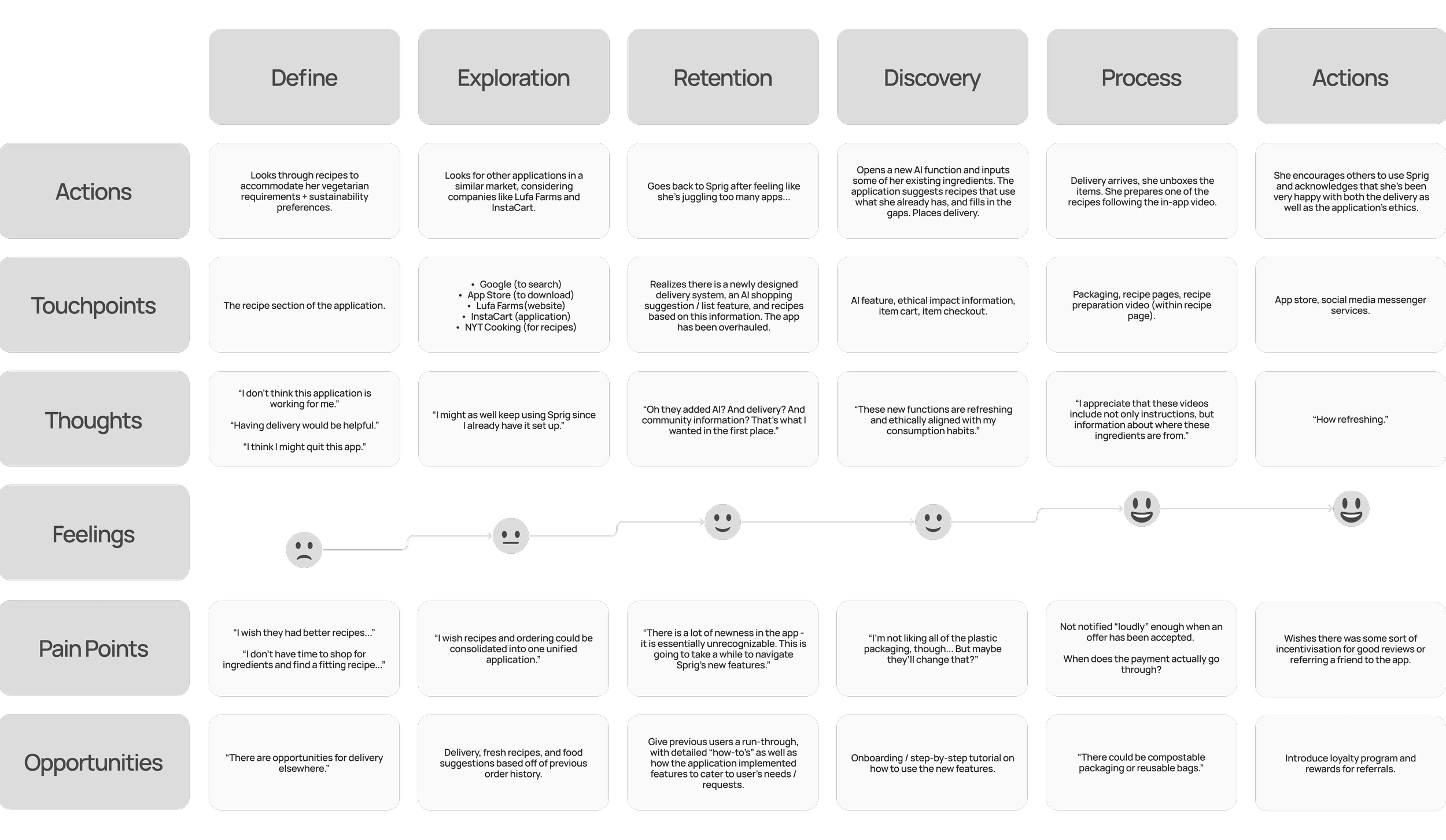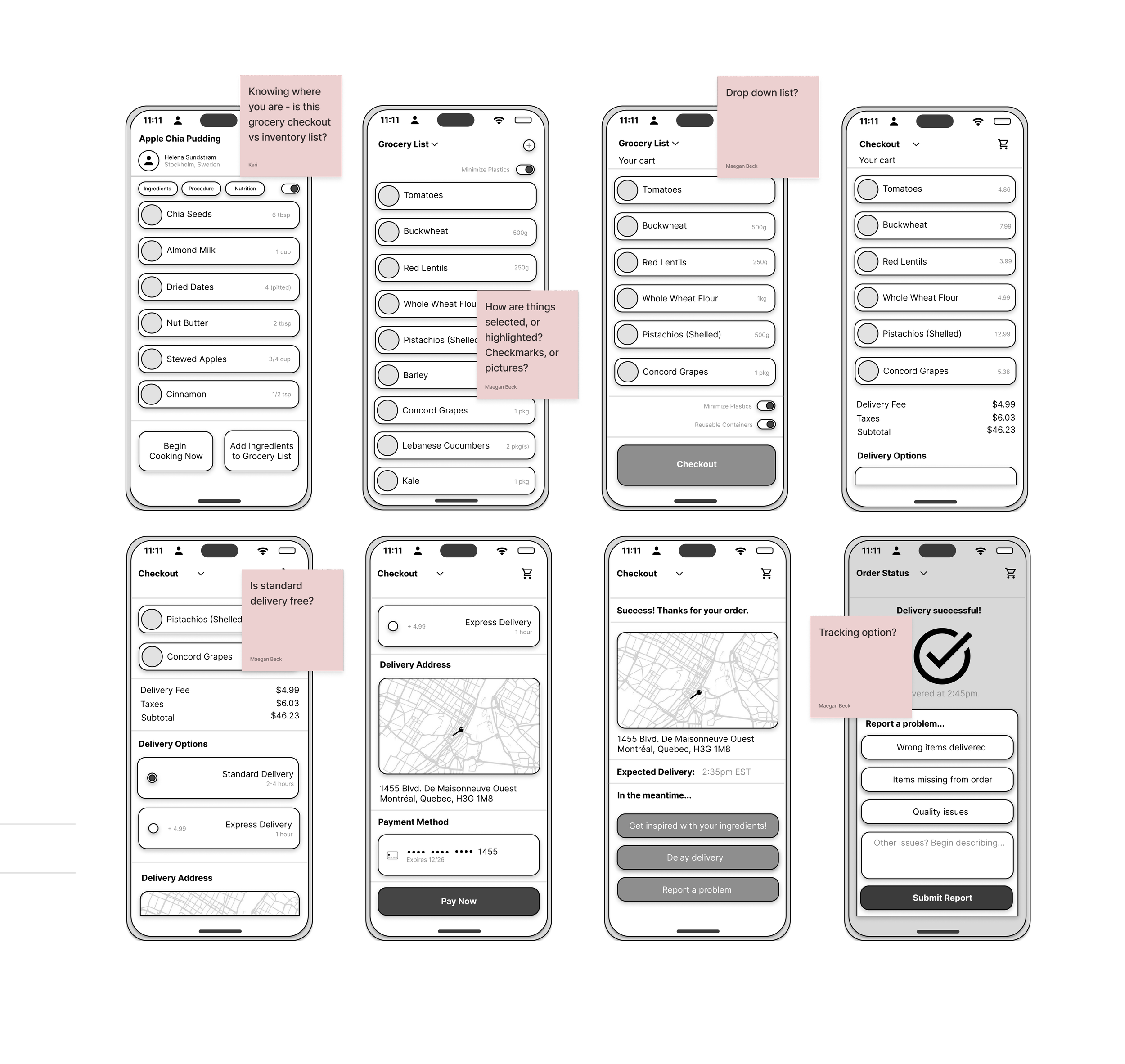Case Study III:
Sprig (re)Design
A UX case study reimagining Sprig as a locally minded, sustainability-forward platform—prioritizing seasonal ingredients, seamless grocery integration, and thoughtful, user-centred planning tools
UX Design
-
Solely onceptualized brand cohesion + identity
Collaboratively defined scope + assumptions
Conducted user interviews + synthesized findings
Developed personas, journey maps, + user flows
Designed low fidelity wireframes to address pain points
Iterated based on usability insights, developing high-fidelity wireframes
Co-presented final design rationale
-
Figma (wireframes, UI design, prototyping)
FigJam (user flows, site map, task analysis)
Zoom (user interviews)
Adobe Photoshop (high-fidelity wireframes)
-
Time-limited scope: 6-week sprint with fixed deadlines
Team dynamics: Collaborative 3-person team with divided responsibilities, requiring consistent alignment
No live user analytics: Relied solely on qualitative feedback and user testing (no in-app data)
Prototype fidelity: Final designs limited to mid-fidelity—no full UI system or dev handoff
Content limitations: Had to work within the existing brand tone and style guide
User access: Limited testing pool; relied on peer testers + assumed familiarity with recipe apps
Tech feasibility: Certain features (e.g. AI recipe generator, grocery integration) were conceptual only
Year: 2025
Role: UX Researcher + Designer
Timeline: 4 Weeks
A UX redesign reimagining Sprig as a sustainability‑driven, farm‑to‑table planning tool. The project prioritizes seasonal sourcing, eco‑friendly grocery flows, and user‑centred systems that support mindful consumption and reduce waste—creating a more cohesive, value‑aligned experience.
Process + Beginning
Research +
Familiarization
Reviewing Sprig’s original app design, we conducted a SWOT analysis that highlighted strong visual cohesion—yet exposed key gaps in personalization, sustainability education, and user engagement.
Competitive Audit
Competitor analysis (such as InstaCart and Lufa Farms) inspired seamless UI + UX patterns, pointing to opportunities for AI-assisted planning and integrated delivery. However, they often lacked tangible evidence of sustainability or community impact.
Persona
+ Journey
Mapping
Persona
After reviewing competitors and assessing Sprig’s existing style guide, our representative persona emerged as someone who prioritizes sustainable eating and low‑impact living. She seeks plant‑forward, high‑protein meals, values conscious ingredient sourcing, and relies on convenient, curated grocery delivery that aligns with her environmental commitments.
Journey Mapping
As an early user, she appreciated the recipe features but felt the app lacked political depth—especially in supporting sustainable practices and personalized grocery solutions. After exploring competitor apps, she returned—revealing strong re-engagement potential if Sprig were to prioritize sustainability, clarity, and meaningful community investment.
1. Lengthy Onboarding
Onboarding and planning felt slow, overwhelming, and ethically ambiguous.
2. Limited Nutritional Needs
Too few options for high-protein recipes.
3. Delivery + Sustainability
No integrated delivery + surface-level insight on community impact and local sustainability.
Key Pain Points
Design Direction:
Ethics-Driven Wireframes for Low-Waste Living
After uncovering key user pain points through journey mapping and persona analysis, we translated these insights into speculative wireframes grounded in sustainability, accessibility, and conscious consumption.
Each frame was designed to streamline core tasks—such as recipe customization, low-impact grocery planning, and delivery preferences—while reinforcing ethical choices and reducing user overwhelm. This section highlights how Sprig’s delivery flow was reimagined to support eco-friendly decisions through intuitive, values-aligned design.
5. Wireframes
Key Features Designed
1. Sustainable Choice Highlights
Surfaced low‑waste or eco‑friendly options with simple, intuitive language for quick comparison.
2. Add-to-List from Recipe
Enabled one-click item transfer from recipes to grocery lists—streamlining planning and prep.
3. Ethical Labeling
Added clear indicators for sourcing, seasonality, and environmental footprint to support informed decisions.
4. Eco‑Aware Delivery Tracking
Live tracking and direct driver communication, with added insights into CO₂ emissions to help users choose lower‑impact delivery options.
Outcomes + Lessons
Add-to-Grocery: Designed for Sustainable Action
Sprig’s new Add-to-Grocery feature bridged the gap between inspiration and action—empowering users to transition seamlessly from recipe discovery to intentional grocery planning. By allowing ingredients to be added directly from recipe pages with one tap, the feature reduced cognitive effort while promoting planned, waste-conscious shopping.
Ethical Utility + Climate-Conscious Convenience
Rather than encouraging overconsumption, the design centered minimalism and responsibility. Integrated portion controls, seasonal substitution suggestions, and bulk-friendly options guided users toward sustainable choices, reframing convenience as a tool for environmental and nutritional care.
ROI: Responsible Engagement + Reduced Waste
The feature supported Sprig’s ethical brand positioning and long-term user retention by aligning everyday behaviors—like grocery shopping—with larger values. By making sustainability the default, not the exception, Sprig increased feature adoption, platform credibility, and the perceived ethical value of the app.
KPIs: Values-Aligned Metrics
Success was measured through increased Add-to-Grocery conversion rates, lower abandonment during the planning phase, and positive sentiment around ease and intention. Follow-up surveys revealed that users felt more confident in their ability to shop ethically, efficiently, and in alignment with personal health and climate values.




